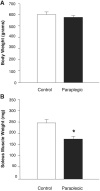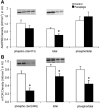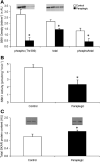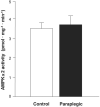Chronic paraplegia-induced muscle atrophy downregulates the mTOR/S6K1 signaling pathway
- PMID: 17885021
- PMCID: PMC2715299
- DOI: 10.1152/japplphysiol.00736.2007
Chronic paraplegia-induced muscle atrophy downregulates the mTOR/S6K1 signaling pathway
Abstract
Ribosomal S6 kinase 1 (S6K1) is a downstream component of the mammalian target of rapamycin (mTOR) signaling pathway and plays a regulatory role in translation initiation, protein synthesis, and muscle hypertrophy. AMP-activated protein kinase (AMPK) is a cellular energy sensor, a negative regulator of mTOR, and an inhibitor of protein synthesis. The purpose of this study was to determine whether the hypertrophy/cell growth-associated mTOR pathway was downregulated during muscle atrophy associated with chronic paraplegia. Soleus muscle was collected from male Sprague-Dawley rats 10 wk following complete T(4)-T(5) spinal cord transection (paraplegic) and from sham-operated (control) rats. We utilized immunoprecipitation and Western blotting techniques to measure upstream [AMPK, Akt/protein kinase B (PKB)] and downstream components of the mTOR signaling pathway [mTOR, S6K1, SKAR, 4E-binding protein 1 (4E-BP1), and eukaryotic initiation factor (eIF) 4G and 2alpha]. Paraplegia was associated with significant soleus muscle atrophy (174 +/- 8 vs. 240 +/- 13 mg; P < 0.05). There was a reduction in phosphorylation of mTOR, S6K1, and eIF4G (P < 0.05) with no change in Akt/PKB or 4E-BP1 (P > 0.05). Total protein abundance of mTOR, S6K1, eIF2alpha, and Akt/PKB was decreased, and increased for SKAR (P < 0.05), whereas 4E-BP1 and eIF4G did not change (P > 0.05). S6K1 activity was significantly reduced in the paraplegic group (P < 0.05); however, AMPKalpha2 activity was not altered (3.5 +/- 0.4 vs. 3.7 +/- 0.5 pmol x mg(-1) x min(-1), control vs. paraplegic rats). We conclude that paraplegia-induced muscle atrophy in rats is associated with a general downregulation of the mTOR signaling pathway. Therefore, in addition to upregulation of atrophy signaling during muscle wasting, downregulation of muscle cell growth/hypertrophy-associated signaling appears to be an important component of long-term muscle loss.
Figures






Similar articles
-
AMPK activation attenuates S6K1, 4E-BP1, and eEF2 signaling responses to high-frequency electrically stimulated skeletal muscle contractions.J Appl Physiol (1985). 2008 Mar;104(3):625-32. doi: 10.1152/japplphysiol.00915.2007. Epub 2008 Jan 10. J Appl Physiol (1985). 2008. PMID: 18187610
-
Endotoxin disrupts the leucine-signaling pathway involving phosphorylation of mTOR, 4E-BP1, and S6K1 in skeletal muscle.J Cell Physiol. 2005 Apr;203(1):144-55. doi: 10.1002/jcp.20207. J Cell Physiol. 2005. PMID: 15389631
-
Alcohol impairs leucine-mediated phosphorylation of 4E-BP1, S6K1, eIF4G, and mTOR in skeletal muscle.Am J Physiol Endocrinol Metab. 2003 Dec;285(6):E1205-15. doi: 10.1152/ajpendo.00177.2003. Epub 2003 Aug 26. Am J Physiol Endocrinol Metab. 2003. PMID: 12944322
-
Regulation of translation initiation by amino acids in eukaryotic cells.Prog Mol Subcell Biol. 2001;26:155-84. doi: 10.1007/978-3-642-56688-2_6. Prog Mol Subcell Biol. 2001. PMID: 11575165 Review.
-
The complexes of mammalian target of rapamycin.Curr Protein Pept Sci. 2010 Sep;11(6):409-24. doi: 10.2174/138920310791824093. Curr Protein Pept Sci. 2010. PMID: 20491627 Free PMC article. Review.
Cited by
-
Placental mammalian target of rapamycin and related signaling pathways in an ovine model of intrauterine growth restriction.Am J Obstet Gynecol. 2009 Dec;201(6):616.e1-7. doi: 10.1016/j.ajog.2009.07.031. Epub 2009 Oct 3. Am J Obstet Gynecol. 2009. PMID: 19800600 Free PMC article.
-
Activity-Based Physical Rehabilitation with Adjuvant Testosterone to Promote Neuromuscular Recovery after Spinal Cord Injury.Int J Mol Sci. 2018 Jun 7;19(6):1701. doi: 10.3390/ijms19061701. Int J Mol Sci. 2018. PMID: 29880749 Free PMC article. Review.
-
Stimulation of skeletal muscle myofibrillar protein synthesis, p70 S6 kinase phosphorylation, and ribosomal protein S6 phosphorylation by inhibition of myostatin in mature mice.Am J Physiol Endocrinol Metab. 2009 Mar;296(3):E567-72. doi: 10.1152/ajpendo.90862.2008. Epub 2009 Jan 13. Am J Physiol Endocrinol Metab. 2009. PMID: 19141683 Free PMC article.
-
Leucine-enriched essential amino acid and carbohydrate ingestion following resistance exercise enhances mTOR signaling and protein synthesis in human muscle.Am J Physiol Endocrinol Metab. 2008 Feb;294(2):E392-400. doi: 10.1152/ajpendo.00582.2007. Epub 2007 Dec 4. Am J Physiol Endocrinol Metab. 2008. PMID: 18056791 Free PMC article. Clinical Trial.
-
Dietary protein recommendations and the prevention of sarcopenia.Curr Opin Clin Nutr Metab Care. 2009 Jan;12(1):86-90. doi: 10.1097/MCO.0b013e32831cef8b. Curr Opin Clin Nutr Metab Care. 2009. PMID: 19057193 Free PMC article. Review.
References
-
- Adams GR, Caiozzo VJ, Baldwin KM. Skeletal muscle unweighting: spaceflight and ground-based models. J Appl Physiol. 2003;95:2185–2201. - PubMed
-
- Baar K, Esser K. Phosphorylation of p70(S6k) correlates with increased skeletal muscle mass following resistance exercise. Am J Physiol Cell Physiol. 1999;276:C120–C127. - PubMed
-
- Baldwin KM, Herrick RE, Ilyina-Kakueva E, Oganov VS. Effects of zero gravity on myofibril content and isomyosin distribution in rodent skeletal muscle. FASEB J. 1990;4:79–83. - PubMed
-
- Bodine SC, Stitt TN, Gonzalez M, Kline WO, Stover GL, Bauerlein R, Zlotchenko E, Scrimgeour A, Lawrence JC, Glass DJ, Yancopoulos GD. Akt/mTOR pathway is a crucial regulator of skeletal muscle hypertrophy and can prevent muscle atrophy in vivo. Nat Cell Biol. 2001;3:1014–1019. - PubMed
-
- Bolster DR, Crozier SJ, Kimball SR, Jefferson LS. AMP-activated protein kinase suppresses protein synthesis in rat skeletal muscle through down-regulated mammalian target of rapamycin (mTOR) signaling. J Biol Chem. 2002;277:23977–23980. - PubMed
Publication types
MeSH terms
Substances
Grants and funding
LinkOut - more resources
Full Text Sources
Medical
Molecular Biology Databases
Research Materials
Miscellaneous

